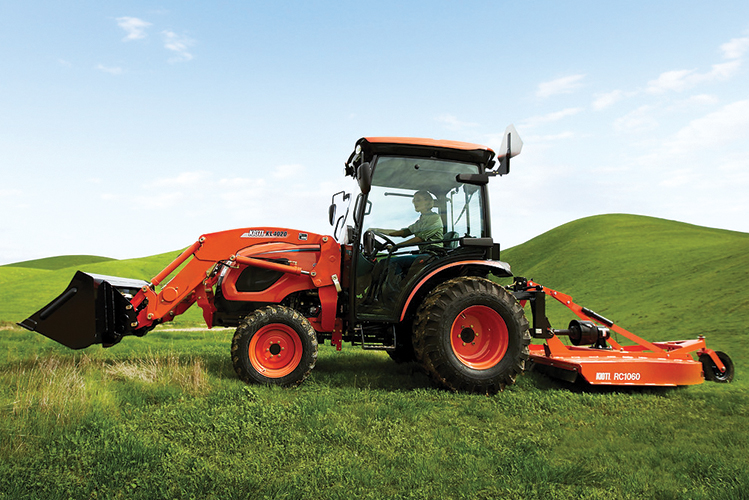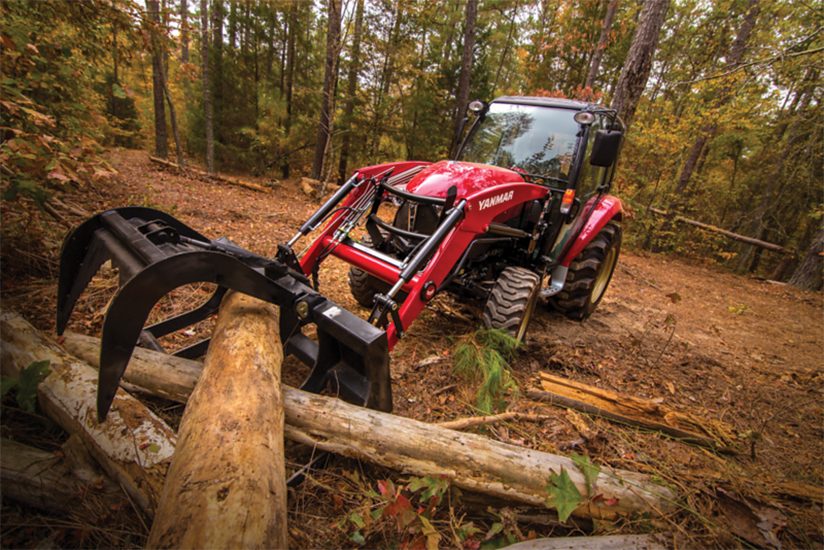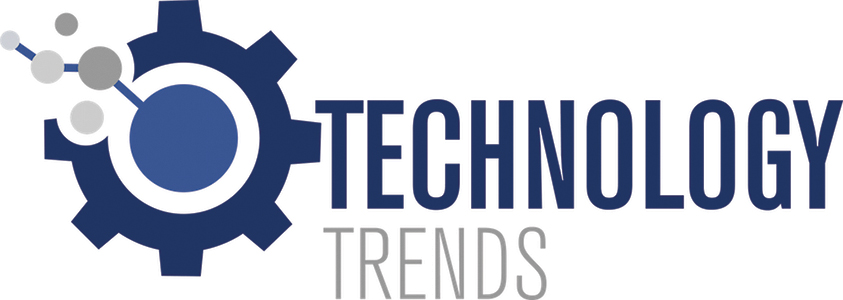Pictured Above:
The Yanmar YT347 compact tractor features an integrated hydro-mechanical transmission, or I-HMT. (Photo Courtesy Of: Yanmar America)
Trade shows and product announcements show off what is available now with new tractor technologies, but what about what’s under development to improve performance and sales opportunities? Details are proprietary, but product experts from several tractor manufacturers highlight new developments in Rural Lifestyle Dealer’s new “Technology Trends” series.
In this first installment, product experts from Yanmar and Kioti share their perspectives. Read on to see what technology they think is most important for the rural lifestyle customer and what those developments will mean for rural equipment dealers.
Yanmar’s Perspective
Daniel Hitchcock, engineering department manager for Yanmar America, shares his view on key tractor technology and what to watch.
Rural Lifestyle Dealer: What recent technology or product enhancement has been pivotal for Yanmar, its dealers and customers?
Daniel Hitchcock: The best example would be our I-HMT, the integrated hydro-mechanical transmission, which we introduced in January 2016, for our YT3 tractor series. The technology is really a melding of the benefits of a gear drive with an HST. It has much higher fuel efficiency and, at the same time, it has the ease of use of an HST.
There will definitely be more evolution of the technology. I can’t tell you specific details, but we have a long history of applying it in Japan and are now bringing this new generation to the U.S.
RLD: Many of the new developments for rural equipment revolve around aesthetics and ergonomics. What is Yanmar developing in those areas and what is the influence from other industries?
Hitchcock: Ease of use and operation and overall ergonomics and comfort are continuous, ongoing improvements. We keep asking ourselves, “What’s the next thing that we can improve for the operator?”
We’re definitely paying attention to the auto and precision ag industries. I expect that we’ll start seeing some of these technologies start working down into compact tractors. One example might be monitoring capabilities. There are trends for more visible information to the customer, whether it’s maintenance or anything else they need — just providing more connectivity between the tractor and the operator.

Daniel Hitchcock is engineering department manager for Yanmar America. (Photo Courtesy Of: Yanmar America)
The cost is prohibitive at this point, but looking long term, technology becomes cheaper when it becomes more commonplace. I don’t see precision and high-end guidance-type technology happening overnight for our market, but when you’re looking ahead 10-20 years, I would say it’s very possible that we will start seeing this technology, especially for compact tractors. You may never see it all the way down to the hobbyist sub-compact models.
RLD: How do you think some of these technologies will be packaged, as options or standard features?
Hitchcock: The majority of new technology will mostly likely be an option. However, there is always a door open, especially if there’s a demand and we can bring it to market competitively.
An example of this is with our model 424 tractor. When it first came to market, there was no differential lock pedal for the tractor. We were getting many requests for this, so it was established as an accessory. We didn’t really expect a lot of demand initially. Over time, we realized this is something many customers would like to have as standard. We brought out a fresh new model this year with the differential lock pedal as a standard feature.
RLD: What about some of the other trends related to robotics and “green” features? What is Yanmar doing in those areas?
Hitchcock: Robotics are a little outside of our scope at the moment, but we’re always focusing on “green.” We’re a very environmentally-focused company, so that’s one of our key focus areas — making tractors that perform more efficiently. Equipment will continue getting cleaner as well, whether that’s through voluntary developments or forced developments because of new environmental regulations.
One of the bigger developments that we already touched on is any kind of smart technology, whether it’s position tracking or just communication with the tractor itself. Many products now have Bluetooth apps where you can see exactly what’s going on with, say, your maintenance schedule. Those kinds of technology will become much more commonplace.
Another thing that I would expect to see improvements on would be anything related to the customer — comfort and ergonomics.
I think probably the last area is improvements in the overall ease of use, simplicity of operation and the intuitiveness of the tractor.
RLD: Are dealers having difficulties selling the benefits of some of these features versus the price?
Hitchcock: I haven’t really heard complaints from that angle. Just like anybody, they’re always going to want a lower price, which is easier to sell. However, before we bring a new product to market, we want to make sure it can be offered at a competitive price.
RLD: How can dealers balance the training needed to keep current with the advances?
Hitchcock: We recently opened a new training center in Acworth, Ga., called the EVO//CENTER that offers training on all our equipment, including industrial engines, construction equipment and agriculture equipment. At the EVO center, dealers can get current, hands-on training with expert technicians, instead of just watching a video.
Kioti’s Perspective
Joel Hicks, Kioti Tractor’s product development manager, and James Little, Kioti dealer liaison, former owner of Little Tractor, and 2008 Rural Lifestyle Dealer Dealership of the Year recipient, share their views on up-and-coming tractor technology.
Rural Lifestyle Dealer: What recent technology or product has been pivotal for Kioti?
Joel Hicks: When talking about pivotal technology and products, it’s important to understand the Kioti customer. In general, they aren’t large producers. Our typical customer is a hobby farmer or a large property owner, so they likely aren’t looking to maximize production or increase efficiency. Instead, they want utility, value and comfort. As such, we’ve been focused on equipment that’s appealing, both in appearance and the features, benefits and function of the unit. For instance, we’ve been continuously improving the layout of the controls and how they relate to the operator. The layout needs to make sense so the tractor is not overly complicated to operate and the experience of using the tractor is enjoyable.
Our customers also want options, so it’s important for us to continue expanding our portfolio, such as having value and premium equipment within our popular CK10 series. In fact, our new CK10 SE models do just that. Additionally, we’re broadening our DK10 lineup. In the next couple of months, cab and ROPS models will be hitting the field with premium features that customers are asking for, like HST transmissions. And, for operators looking for electronically-controlled functions, we offer the premium NX, RX, and PX platforms. With all these models, customers can choose which tractor works best for them.

Joel Hicks is Kioti Tractor’s product development manager. (Photo Courtesy Of: Kioti)
RLD: What new technologies do you see that might be adapted from the automotive or production agriculture industries?
Hicks: GPS has had a big impact on production agriculture and that technology will continue to evolve in such areas as autonomous, self-guided machines. We may eventually see some of that technology in our market, but not for a long time or at least until the price point of that technology comes down. This market is really price sensitive and utility-focused.
Over the next 5-10 years, smartphone interfaces will more likely be of interest to our customers. For instance, the interface might send them an email once a month that says, “Here’s how all my systems check out,” or “It’s time to be serviced.” Additionally, wireless connectivity, Bluetooth technology and satellite radios are likely what our customers are most interested in from a technology standpoint.
RLD: James, can you explain your new role and your thoughts on that technology from a dealer’s perspective?
James Little: I started working with Kioti about 3 months ago and I’m in dealer development. I visit new dealers to help them get up and running in the business and help all dealers optimize sales and relationships and build their market share.
I agree with Joel’s comments on smartphone interfaces for our customer base. This kind of technology could help dealers stay in contact with their customers and help them provide even better service after the sale.
I think it’s important to remember — when it comes to technology — who our customer is. Many of them have 3, 5 or 10 acres, and they are operating their tractors in their downtime, for relaxation. So, as far as needing all the technology of the large ag tractors, it’s doubtful. All of that could take away from what our customers are looking for.
RLD: Now that you’ve transitioned from being a dealer to working for a manufacturer, what kind of reception have you gotten from dealers?

James Little is Kioti dealer liaison, former owner of Little Tractor, and 2008 Rural Lifestyle Dealer Dealership of the Year recipient. (Photo Courtesy Of: Kioti)
Little: Actually, very good. Many want to talk with me about their challenges and opportunities. Mainly, dealers have challenges with advertising and marketing. They are sometimes intimidated by that part of the business. A lot of the dealers can work on tractors, build relationships with customers, get involved in the community, but back off a little bit where it comes to advertising and promotions. So, part of my job is to help them understand that “new world” and to make it work for them.
RLD: Are you hearing from dealers that customers are choosing to upgrade machines because they are looking for new technology as opposed to upgrading for size and power?
Little: For our customers, size and power are number one and comfort usually comes in a very close second. Ultimately and generally, they want a piece of equipment that’s reliable and will get the job done, and will also be enjoyable to operate. So, many times they’ll opt in for a premium model or a cab tractor with heat and air conditioning.
Another factor is the dealer relationship. If the dealer takes really good care of the customer, the customer is going to come back again and again.
RLD: There are some new entrants in the compact tractor market, with simple designs and without computer components. Do you see some demand developing for that kind of tractor, maybe in specialty markets?
Hicks: There’s certainly a small portion of the market that makes sense for these machines, but, emission requirements play a role in how broad that market is or can be. There currently aren’t too many companies in the market, if anyone, that offers a 30+ horsepower engine that will operate, perform, and meet emissions standards without some sort of engine controls or computer. There are some specialty markets that will support this kind of tractor, but the companies focused on building that machine will likely be limited to a small portion of the overall compact tractor market.
RLD: What is Kioti doing to keep dealers trained, while keeping in mind they need to keep people in the dealership working on equipment?
Hicks: Currently, we are expanding our training program to offer more touches per year, per individual. There are a wide range of training options — from in-person and hands-on to electronically and over the web. First, we are providing more opportunities for dealers and technicians to receive training at our headquarters. Second, understanding techs need to be where their customers are, we’re adding multiple e-learning options they can tap into from their dealership. Additionally, our Kioti field service technicians travel around North America to our dealers. At their visits, they aren’t just fixing equipment, but instead working with dealer technicians onsite to diagnose, troubleshoot and maintain the equipment together using the latest tools and techniques. This is a real-time, effective training tool that’s seeing great success.
RLD: What about research into battery-powered equipment? Is that on the horizon for Kioti?
Hicks: It’s not really something that we’re focused on for the tractor market. The big question for this type of equipment is the amount of work that you want to get out of it. Even though battery technology has advanced a lot, especially in the last 10 years, it still has to advance farther just to get 6-8 hours’ worth of run-time or more every day, and be able to do that day in and day out. Advancements in things like quick-charge capabilities are also needed to make this technology viable. I wouldn’t rule it out, but I don’t know that it’s going to be a game-changer in the next 5-10 years.

Kioti recently extended its CK10SE Series line-up, with engine gross horsepower options (34.9 horsepower or 39.6 horsepower), PTO options (28-34.9 horsepower) and synchronized shuttle or hydrostatic ROPS or hydrostatic cab models. (Photo Courtesy Of: Kioti)






Post a comment
Report Abusive Comment